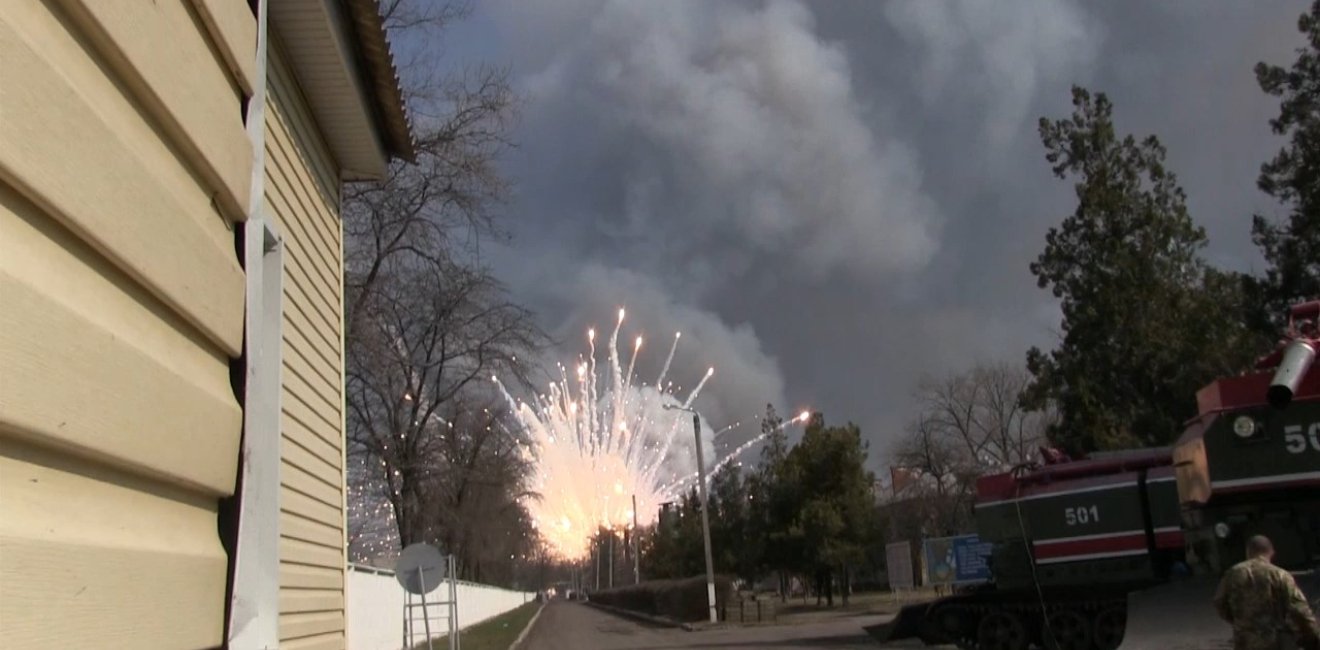
A blog of the Kennan Institute
Almost from the onset of the conflict in eastern Ukraine in 2014, many organizations have called for action to reduce the risk of shelling of industrial sites containing chemicals. Protecting chemical facilities across Ukraine is a no less important task. This can be explained by many reasons.
The State Emergency Service of Ukraine counts approximately 900 chemically dangerous sites in Ukraine. Although many are located in Donetsk region, regions such as Dnipropetrovsk and Kharkiv cumulatively accommodate more facilities where chemicals are produced, used, or stored in large quantities. Ukraine’s national legislation does not explicitly require operators of chemical facilities to install security measures. However, Ukraine’s low security rating on the 2017 Global Terrorism Index, owing to disturbingly frequent security incidents, indicates the need to tighten security at Ukraine’s critical infrastructure sites.
Whereas in the East, ceasefire violation monitoring by the Organization for Security and Cooperation in Europe (OSCE) might help trace and consequently deter a deliberate or negligent attack against chemical installations, difficulties with attribution, as showcased by the explosions in the ammunition depots near Kharkiv and Vinnytsya, can add a stimulus for malevolent actors to employ chemicals or perpetrate sabotage against chemical plants in a government-controlled area of Ukraine. This could damage national security and the economy and destabilize the political climate in the country, and therefore necessitates the enactment of stringent security measures.
As the United States has a real interest in preserving Ukraine’s economic viability and continues to be a significant contributor to Ukraine’s national security, assisting in enhancing the country’s chemical security is a logical path to follow. It would help the United States secure its borders from the chemical menace by limiting unauthorized access to chemical materials and preventing them from falling into terrorists’ hands inside countries where state control over dual-use materials[1] and facilities is fragmented. To maximize gains for the United States and Ukraine, American actions in the chemical security domain should encompass both legislative and institutional assistance, as well as increased visibility about its actions.
Legislative Assistance
The United States has a good track record implementing chemical security legislation. The Chemical Facilities Anti-Terrorism Standards (CFATS), initially authorized by Congress in 2007, were developed to prevent the intentional misuse of chemicals through theft, sabotage, or attack and thus to improve overall security in the country.[2] As per CFATS regulations, a chemical facility that uses any of the Chemicals of Interest (COI) in certain quantities established by the Department of Homeland Security (DHS), in addition to reporting and maintaining comprehensive records of COI, is required to develop and implement site security plans. The United States has a four-tier system for classifying chemical facilities based on estimated security risk. Tier 1 represents the highest risk. The DHS performs regular inspections of high-risk chemical establishments to ensure that security measures are in place.
Ukraine also has a methodology for chemical facilities classification, but in contrast to the one described above, determination of the risk level is based on the consequences of an inadvertent chemical incident. Chemical sites are categorized in four classes depending on the size of the population potentially affected by an emergency. In other words, classification is done based on estimated safety risk; potential danger from an intentional malevolent act is not considered.
To address this, a starting point for Ukraine would be to make an inventory of chemicals and establishments that should be covered by chemical security legislation and correlate them with the CFATS COI list. This list, in addition to dual-use chemicals (also controlled by Ukraine), includes toxic and flammable chemicals, chemicals that can create “weapons of mass effect,” and other chemicals conducive to sabotage.
Overhauling the classification of high-risk facilities is also required, and the moment is just right. Ukraine is in the process of implementing Directive 2012/18/EU on the control of major-accident hazards involving dangerous substances (Seveso III Directive), as stipulated by the Association Agreement between the European Union and Ukraine. Integrating obligations pertinent to chemical security into the body of Ukrainian legislation harmonized with the Seveso III Directive might generate quite complex regulation. However, in the end, it will help avoid unnecessary administrative burdens caused by having to undergo a similar lengthy lawmaking process in the future and, most important, buttress security in the country.
Institutional Support
Ukraine lacks a coordinating agency to spearhead chemical security, diluting attention to the problem. The National Security and Defense Council (NSDC) of Ukraine, which includes the heads of the law enforcement ministries in Ukraine, might be a good candidate to elevate the chemical security agenda to the appropriate strategic level. The precedent is there: a commission on biosecurity and bioprotection was recently established under the NSDC. Why not use the momentum for chemical security? For example, in the United States, chemical and biological threats are regarded in the same weapons of mass destruction (WMD) portfolio in the recently created special office in the DHS.
To act in a similar fashion, Ukraine needs an impetus, and the United States has leverage. For example, before embarking on the path associated with the chemical security legislative assistance program described above, the United States could set a condition on Ukraine to establish a coordinating body and divide labor pertaining to day-to-day chemical security functions between respective executive bodies with sufficient human and administrative resources. Here, peer support from the United States in setting up an inspection office would be instrumental for Ukraine, where positive experience is as important as the challenges and problems faced.
Such an arrangement could be a win-win solution. It would help the United States safeguard the effectiveness and sustainability of aid provided and would challenge the possible perception of the United States as a donor that merely dumps equipment on Ukraine. For Ukraine, it would help prepare the groundwork for an advanced security reform.
Increased Visibility and Outreach
Preventing terrorists and rogue states from accessing and using WMD has long been at the forefront of U.S. policy; the 2010–2016 U.S.-led Nuclear Security Summit process is an example. At the same time, chemical sector security summits organized by the United States do not enjoy that much publicity and are smaller in scale and scope. Boosting the image of the United States as a global WMD nonproliferation and security actor requires actions in the field where the impact would be discernible. Launching state-of-the art chemical security assistance projects for Ukraine, for example, would pay back not only in increased security but also geopolitical dividends to the United States and—what is salient—with no moral hazards. This fits well in the realm of international law.
Already in 2004, some years after 9/11, the United Nations Security Council (UNSC) unanimously adopted Resolution 1540, obliging states “to refrain from supporting by any means non-State actors from developing, acquiring, manufacturing, possessing, transporting, transferring or using nuclear, chemical or biological weapons.” In this context, assisting Ukraine in enhancing the country’s chemical security would help Ukraine fulfill its obligations under UNSC Resolution 1540 (2004) and Resolution 2325 (2016). The latter specifically calls on all states to intensify efforts to achieve full implementation of resolution 1540 (2004) and encourages states “to contribute funds, on a voluntary basis, to finance projects and activities … to assist States in implementing their obligations under resolution 1540 (2004).”
For Ukraine, which lags behind in aspects of critical infrastructure security, a chemical security assistance program would provide an opportunity to amend the status quo by building organizational security architecture in high-risk establishments. Although the United States has long played a huge role in supporting reforms in Ukraine, it has not always received proper public recognition. Therefore, greater outreach efforts should be made to send a positive signal to the international and local community and help them acknowledge progress in this area. During the next session of the Verkhovna Rada, starting on February 6, 2018, the Ukrainian parliament will be largely preoccupied with reform of the security and defense sector of Ukraine, and Ukraine would welcome further cooperation with the EU and NATO countries. The area of infrastructure security is a natural one for further bilateral efforts, as the United States, together with the EU, already is supporting the OSCE’s chemical safety and security projects. Now is the right time to enlarge the scope and scale of the effort.
[1] Dual-use materials are those normally used for civilian purposes but which may have military applications (http://ec.europa.eu/trade/import-and-export-rules/export-from-eu/dual-use-controls/index_en.htm).
[2] Before 2015, President Obama signed into law the CFATS Act of 2014, which recodifies and reauthorizes the CFATS program for four years. This was done after a positive outcome of the review of the effectiveness of the program.
Author


Kennan Institute
After more than 50 years as a vital part of the Wilson Center legacy, the Kennan Institute has become an independent think tank. You can find the current website for the Kennan Institute at kennaninstitute.org. Please look for future announcements about partnership activities between the Wilson Center and the Kennan Institute at Wilson Center Press Room. The Kennan Institute is the premier US center for advanced research on Eurasia and the oldest and largest regional program at the Woodrow Wilson International Center for Scholars. The Kennan Institute is committed to improving American understanding of Russia, Ukraine, Central Asia, the South Caucasus, and the surrounding region through research and exchange. Read more

Explore More in Focus Ukraine
Browse Focus Ukraine
Talking to the Dead to Heal the Living

Ukrainian Issue in Polish Elections


